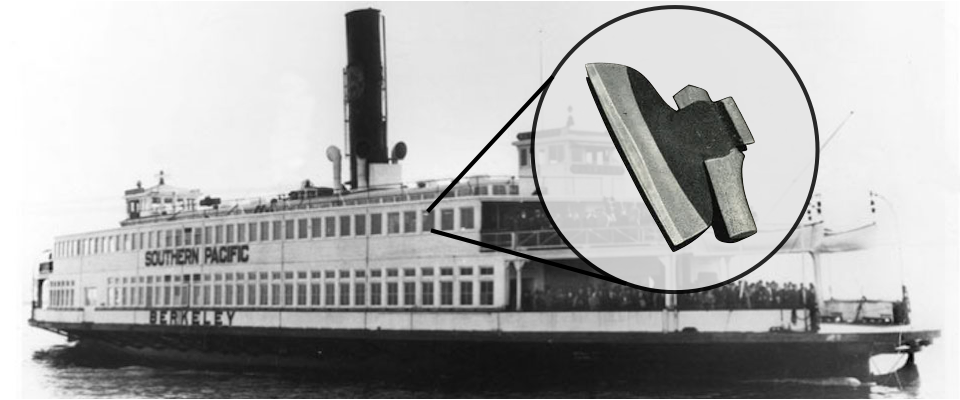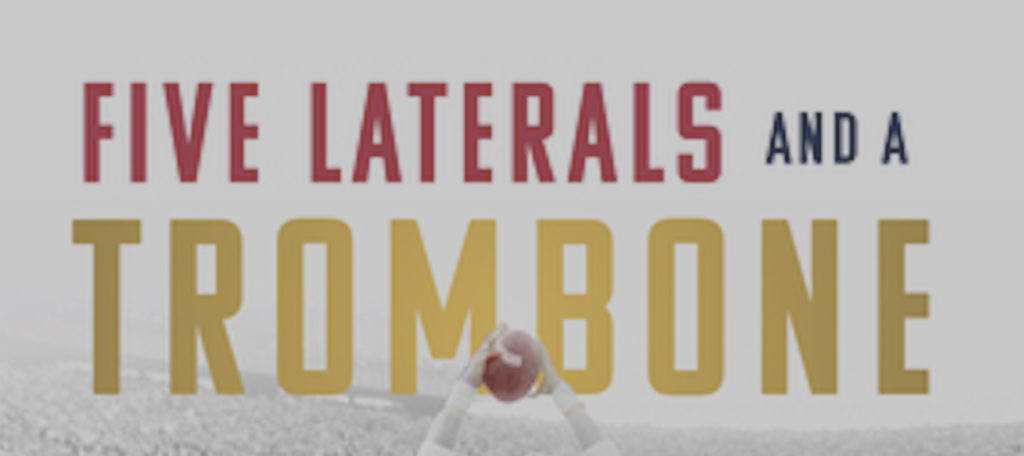One of the most celebrated chapters in the history of the Cal–Stanford rivalry is the story of how some intrepid Cal students stole the Axe in 1899 after a baseball game in San Francisco and led the police and a mob of irate Stanford fans, including the student body president, on a frantic chase to the Ferry Building.
According to legend, the ringleader was Clinton Miller 1900, who spotted the cops searching every male student boarding the boat. Just in the nick of time, he ran into an old girlfriend and convinced her to hide the hatchet under her skirt, and they made their escape on the last boat to Oakland.
Great story, huh? Trouble is, it’s not true. And we have an improbable team of a Stanford man, Carl Hu, who has written extensively about the caper, and a Cal man, Cameron Wolfe ’61, J.D. ’64, to thank for uncovering the facts.
It turns out that the real thief was Everett Brown 1898, Cameron’s grandfather. Miller took the rap—or the credit, depending on your point of view—to protect him. And there was no old girlfriend; it was actually Everett in drag.
“He saw the cops waiting as he got to the Ferry Building, so he quickly bought a dress from a pushcart peddler at the foot of Market Street and changed in a nearby alley, and he and Clint Miller walked onto the boat as a couple,” says Carl.
“But his mother and grandmother were horrified when they heard about it,” adds Cameron. “His grandmother was the wife of the richest man in town, Frederick Delger, who owned all of downtown Oakland between Telegraph and Broadway, from 8th to 20th Street. They were afraid that the scandal would harm his budding legal career. So Clint agreed to take the blame. It wasn’t the theft that appalled them so much; it was that he had dressed as a woman.”
The cover-up worked. Everett ended up as a judge on the Alameda County Superior Court, as well as president of the Cal Alumni Association.
The legend says the Axe was hidden for years in a safe in a local photographer’s studio, but that’s not true, either.
“Everett took the Axe to his grandmother’s house and hid it in his own bedroom,” says Cameron. “The following Monday, he took it to campus, and an impromptu rally commenced, which was reported the next day in the Daily Cal. All of this is reenacted with a skit every time we have a family reunion.”
The Axe remained hidden from sight for the next 30 years, except for an unveiling at the annual Big Game rally in the Greek Theatre, until it was stolen back in a daring raid by a group of Stanford students, known thereafter in Palo Alto as the Immortal 21. After that, the administrations of the two schools decided to put an end to all the high jinks by awarding the Axe to the winner of each year’s Big Game.
It’s mounted on a wooden plaque with a brass panel listing the scores of all the previous Big Games. Whenever Stanford wins, its rally committee changes the score of the 1982 game, which Cal won on that famous last-second, five-lateral kickoff return known as “The Play,” to a 20-19 Stanford victory. When Cal wins, our rally committee changes it back to the real score, 25-20.
And the ferryboat that Everett escaped on with his precious purloined cargo? Carl tracked that down, too. It’s both a California Historical Landmark and a National Historic Landmark, docked at the Maritime Museum of San Diego. Its name: the Berkeley, of course.
In other gridiron lore, have you ever wondered how the members of the Cal Marching Band are able to keep following band director Matt Sadowski’s hand gestures when they’re marching?
“They can’t,” says Barbara Hollimon Goodson ’81. “When you’re out on the field, you might be facing any direction. That’s why there are always four directors on the field: one on each sideline, Matt and Andy LaBatt ’95, and one in each end zone, Pete Alvarez ’71 and me. The three of us never take our eyes off Matt, and we make sure our hands are exactly the same as his hands when we direct.”
Barbara got her bachelor’s in 1981, but like all band members, she prefers to identify with the year she joined the band, 1977. “When you enroll in a university that’s as big as Cal and has as many opportunities to study and different living situations, you really need a home. Not necessarily a physical home, but a place where you can make friends and everybody is working toward the same purpose.
“This is the heart of why the Cal Band has been so important to me, both as an undergrad and as an alumna. Being with the band was a tremendous amount of work, but the times I had the most work to do for the band were the times when I did best in school.”
In addition to directing for the band, Barbara also plays with the Alumni Band and a San Francisco Bay Area–based ensemble called the California Repercussions, a.k.a. the Reapers, which plays everything from John Philip Sousa to Queen. Her instrument is the mellophone, which looks like a big trumpet and has the same fingerings.
“The Alumni Band also gets to play at a home game each year,” she says. “It’s always a game when there will be no band coming with the visiting team.”
Barbara has been the band’s north end zone director for the last 15 years, and two years ago, she achieved her fondest dream: replacing Sadowski for one game, when the band presented a Girl Power show featuring music by female recording artists, making her the first woman to be primary director in the band’s history.
“A week before the show, one of the executive committee members came to me and said, ‘We would love it if you would be the main director for the halftime show, and Matt agrees.’ Of course I said yes! It was the thrill of a lifetime!”
When I first met Adena Ishii ’14 in 2016, she had just been hired as a consultant by the Berkeley–Albany–Emeryville chapter of the League of Women Voters to advise them on how to attract younger members.
Her first suggestion, to move the meetings to evenings because young people have to work in the afternoon, helped membership jump by 50 percent. But she had taken the job on one condition: She’d only do it for a year.
So, 12 months later, I called her and asked, “What are you doing now?”
“I never left!” she said. “They elected me president!”
And what has she been up to since then? “I just got elected to the state board. I’ll be leading the diversity, equity, and inclusion committee and helping with fundraising. Unlike the local chapters, the state League has a whole staff and a lobbyist, and my job is to make sure we can pay them. Also, to make things fun, I [completed] an internship with the national League.”
And if that wasn’t enough, she also adopted a teenage girl and got married. Because of the pandemic, the wedding guests had to attend virtually. “But we held the ceremony in person at the foot of the Campanile. I’m a Golden Bear through and through.”
Great news if you’ve got cabin fever from sitting home so much: After locking down along with everyone else, Cal Discoveries has started up its tours again. And to make sure no stone is left unturned, Cal Discoveries’s senior director, Joanna Aguiar, joined an advanced planning cruise to Alaska, along with 60 regular passengers.
“We wanted to make sure all the COVID-19 protocols were in place and being implemented,” she says. “And there were no slips. The passengers were very cooperative and understanding, too. Everyone was taking personal responsibility to make sure the experience was safe and happy for everyone.”
Lorne Brown, J.D. ’64, and his wife, Ursula, were two of the passengers on one of these first few trips who also gave the experience a thumbs-up. They sailed on a circumnavigation of Iceland.
“We’ve taken many trips with Cal Discoveries,” says Ursula. “We used to be the youngest people on these trips; now we’re among the oldest. On the first night, we met a lovely couple. We were very like-minded. Most Cal people are, which is one of the beauties of traveling with Cal Discoveries.”
“The lectures by the Cal professors on the tours have turned out to be delightful,” adds Lorne. “Especially a professor in the environmental sciences department named Vince Resh. He was a fountain of knowledge [during a South Africa trip], and he was willing to share all the things he knew.”
While on the Iceland excursion, they got their pictures taken touching a huge ball that stands at the Arctic Circle, which isn’t as easy as it sounds.
“The Circle keeps moving north because of changes in the magnetic field, so they have to keep moving the ball to keep up with it,” says Ursula. “Eventually, it will be on no land at all, just water. We learned that from Cal Discoveries.”
They saw puffins and Arctic terns and geothermal eruptions shooting out of Arctic glaciers. “Fire and ice, that’s what Iceland is all about,” she says. “Cal always researches the environment and provides information to help you understand it.”
“We have never had a bad trip,” adds Lorne. “Never. And we’ve taken a lot of them.”
If you want to check out the upcoming excursions, visit alumni.berkeley.edu and click on the Travel tab.




















